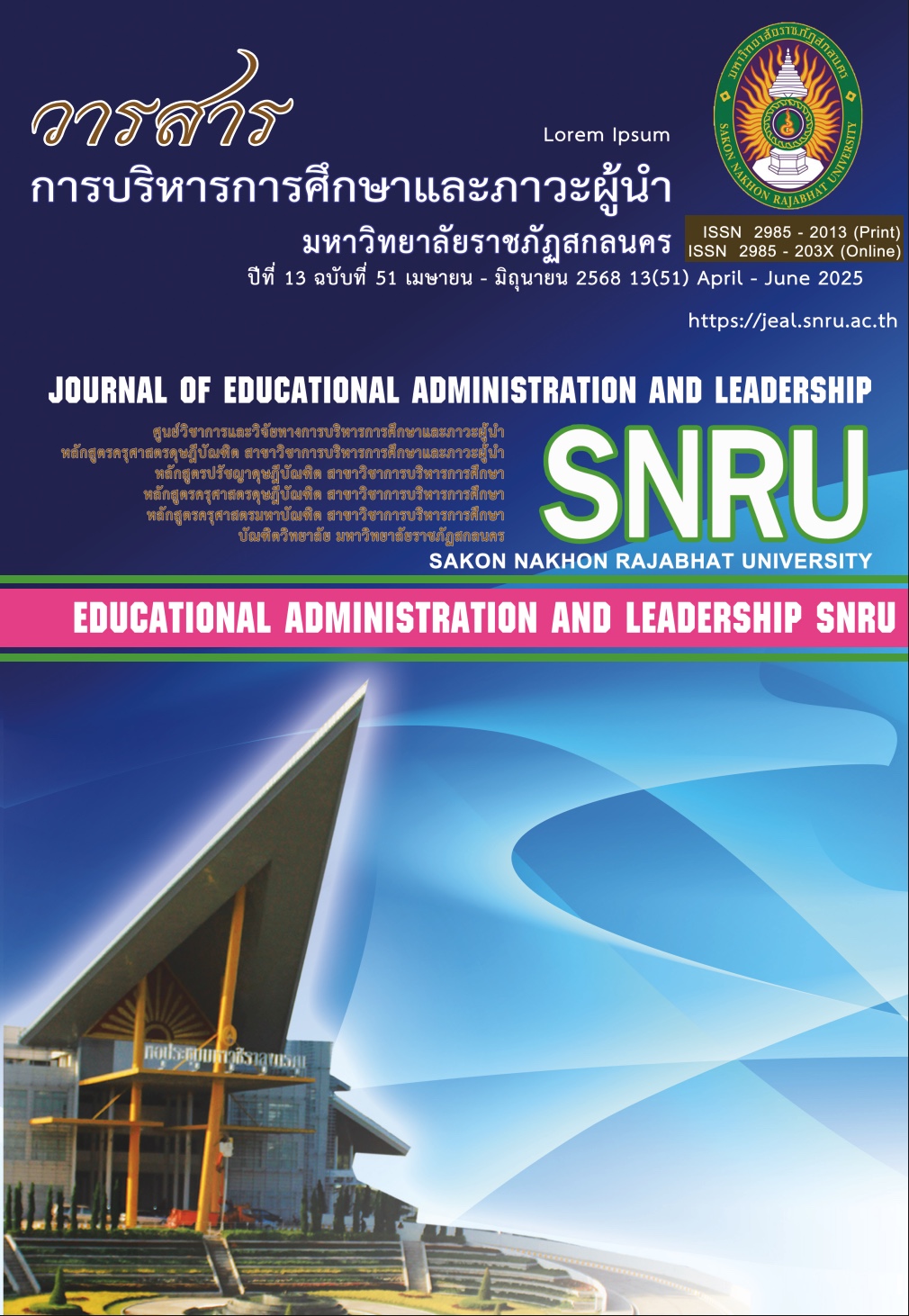

ปัจจัยทางการบริหารที่ส่งผลต่อสมรรถนะของครูในศตวรรษที่ 21 สังกัดสำนักงานเขตพื้นที่การศึกษามัธยมศึกษาสกลนคร
Administrative Factors Affecting the Teacher’s Competencies in the 21St Century Under The Secondary Educational Service Area Office Sakon Nakhon
ผู้แต่ง
ศิริภรณ์ สอนสา, สุมัทนา หาญสุริย์, ฐปนีย์ นารี
Author
Siriporn Sonsa, Sumatthana Hansuri, Thapanee Naree
บทคัดย่อ
การวิจัยครั้งนี้มีความมุ่งหมายเพื่อศึกษา เปรียบเทียบ หาความสัมพันธ์ หาอำนาจพยากรณ์และหาแนวทางพัฒนาปัจจัยทางการบริหารที่ส่งผลต่อสมรรถนะของครูในศตวรรษที่ 21 สังกัดสำนักงานเขตพื้นที่การศึกษามัธยมศึกษาสกลนคร กลุ่มตัวอย่าง ได้แก่ ผู้อำนวยการโรงเรียน รองผู้อำนวยการโรงเรียนกลุ่มงานบริหารวิชาการ และครูผู้สอน ในปีการศึกษา 2566 จำแนกเป็นผู้อำนวยการโรงเรียน จำนวน 45 คน รองผู้อำนวยการโรงเรียนกลุ่มงานบริหารวิชาการ จำนวน 45 คน และครูผู้สอน จำนวน 245 คน กำหนดขนาดของกลุ่มตัวอย่างโดยใช้ตารางเครจซี่และมอร์แกน (Krejcie & Morgan,1970) และสุ่มแบบแบ่งชั้นอย่างเป็นสัดส่วนตามขนาดโรงเรียน เครื่องมือที่ใช้ ได้แก่แบบสอบถาม และแบบสัมภาษณ์ ซึ่งแบบสอบถามเกี่ยวกับปัจจัยทางการบริหาร มีค่าอำนาจจำแนกอยู่ระหว่าง 0.25 - 0.81 และมีค่าความเชื่อมั่น เท่ากับ 0.95 และสมรรถนะของครูในศตวรรษที่ 21 ค่าอำนาจจำแนกอยู่ระหว่าง 0.27 - 0.72 และมีค่าความ 0.91 สถิติที่ใช้ในการวิเคราะห์ข้อมูล ได้แก่ ความถี่ ร้อยละ ค่าเฉลี่ย ส่วนเบี่ยงเบนมาตรฐาน การทดสอบเอฟ การวิเคราะห์ความแปรปรวนทางเดียว ค่าสัมประสิทธิ์สหสัมพันธ์อย่างง่ายของเพียร์สัน และการวิเคราะห์การถดถอยพหุคูณทีละขั้นตอน
ผลการวิจัยพบว่า
1. ปัจจัยทางการบริหาร โดยรวมและรายด้านอยู่ในระดับมาก
2. สมรรถนะของครูในศตวรรษที่ 21 โดยรวมและรายด้านอยู่ในระดับมาก
3. ปัจจัยทางการบริหาร จำแนกตามสถานภาพการดำรงตำแหน่ง จำแนกตามขนาดโรงเรียน และประสบการณ์ในการปฏิบัติงาน โดยรวมไม่แตกต่างกัน
4. สมรรถนะของครูในศตวรรษที่ 21 จำแนกตามสถานภาพการดำรงตำแหน่ง โดยรวมไม่แตกต่างกัน ส่วนจำแนกตามขนาดโรงเรียนและจำแนกตามประสบการณ์ในการปฏิบัติงาน พบว่า โดยรวมแตกต่างกัน
อย่างมีนัยสำคัญทางสถิติที่ระดับ .05
5. ปัจจัยทางการบริหารกับสมรรถนะของครูในศตวรรษที่ 21 โดยภาพรวมมีความสัมพันธ์กันทางบวก อย่างมีนัยสำคัญทางสถิติที่ระดับ .01 โดยมีความสัมพันธ์กันอยู่ในระดับปานกลาง (rxtyt = 0.491**)
Abstract
This research aimed to study, compare, examine relationships, determine predictive power, and develop guidelines for improving administrative factors that influence the 21st century teacher competencies in schools under the Secondary Educational Service Area Office, Sakon Nakhon. The sample group included school principals, deputy principals for academic affairs, and teachers in the academic year 2023, consisting of 45 school principals, 45 deputy principals for academic affairs, and 245 teachers. The sample size was determined using Krejcie and Morgan’s table (1970) and selected through stratified random sampling based on school size. The research instruments included questionnaires and interviews. The questionnaire on administrative factors had a discrimination index ranging from 0.25 to 0.81 and a reliability coefficient of 0.95, while the questionnaire on 21st century teacher competencies had a discrimination index ranging from 0.27 to 0.72 and a reliability coefficient of 0.91. Data analysis employed frequency, percentage, mean, standard deviation, F - test, one - way ANOVA, Pearson’s simple correlation coefficient, and stepwise multiple regression analysis.
The research findings revealed that:
1. The overall administrative factors and individual aspects were at a high level.
2. The overall 21st century teacher competencies and individual aspects were at a high level.
3. Administrative factors, when categorized by job position, school size, and work experience, showed no significant differences overall.
4. The overall 21st century teacher competencies showed no significant differences based on job position. However, when categorized by school size and work experience, significant differences were found at the 0.05 level.
5. A significant positive correlation at the 0.01 level was found between administrative factors and 21st-century teacher competencies, with a moderate correlation level (r = 0.491).
6. Among the five analyzed administrative factors, three factors significantly predicted 21st-century teacher competencies at the 0.01 level: information technology, budget, and organizational climate and culture. These three factors together accounted for 33.80% of the variance in teacher competencies, with a standard error of prediction of 0.17466.
7. The proposed guidelines for developing administrative factors influencing 21st century teacher competencies focused on three areas: (1) Information technology: School principals should support the use of online platforms to enhance modern learning; (2) Budget: School principals should efficiently manage budgets across all areas, including teacher and student development, infrastructure, and technology, to ensure school readiness and competitiveness; (3) Organizational climate and culture: School principals should foster a transparent and inclusive environment where all stakeholders feel engaged, confident, and valued.
คำสำคัญ
ปัจจัยทางการบริหาร, สมรรถนะของครูในศตวรรษที่ 21Keyword
Administrative Factors, Teacher Competencies in the 21st Century.Notice: Undefined variable: dataSet in /var/www/html/ArticleView.php on line 116
Notice: Trying to access array offset on value of type null in /var/www/html/ArticleView.php on line 116
บทความทุกบทความเป็นลิขสิทธิ์ของ
Notice: Undefined variable: dataSet in /var/www/html/ArticleView.php on line 116
Notice: Trying to access array offset on value of type null in /var/www/html/ArticleView.php on line 116
เท่านั้น
กำลังออนไลน์: 8
วันนี้: 0
เมื่อวานนี้: 979
จำนวนครั้งการเข้าชม: 725,092
อาคารบัณฑิตวิทยาลัย ชั้น 2 ตำบลธาตุเชิงชุม อำเภอเมือง จังหวัดสกลนคร 47000
โทร/
แฟกซ์ 0-4297-0093
บรรณาธิการ: รองศาสตราจารย์ ดร.ไชยา ภาวะบุตร
ติดต่อ/สอบถาม: นายธีรเวทย์ เพียรธัญญกรณ์
โทร: 0-4297-0093